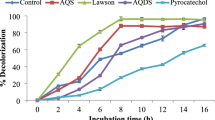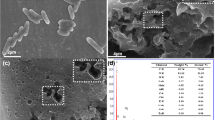Abstract
The aim of this study was to evaluate the redox mediating capacity of anthraquinone-2,6-disulfonate (AQDS) immobilized on granular activated carbon (GAC) during the reductive decolorization of direct blue 71 (DB71) under microbial and chemical conditions. The immobilization of AQDS on GAC was conducted by adsorption, and it has obtained an uptake capacity of 0.227 mmol g−1. The anchorage of AQDS on GAC improved its electron transfer capacity (ETC) up to 2.05 times higher than the raw material. Similarly, the addition of GAC-AQDS increased up to 1.75- and 1.16-fold the rate of decolorization (k d ) of DB71 under microbial and chemical conditions, respectively, in comparison to the unmodified GAC. Surprisingly, a higher k d value was achieved in incubations without either GAC or GAC-AQDS because of the generation of aromatic amines, from the reduction DB71, taking into account that these species may act as a catalyst in the DB71 reduction process. In contrast, adsorption of aromatic amines on either GAC or GAC-AQDS decreased its redox mediating capacity as evidenced by spectrophotometric screenings of the decolorized solution and the supporting material. The development of materials with enhanced both redox and adsorption properties, as the GAC used in this study, offers a promising way to increase the redox conversion of recalcitrant pollutants commonly found in industrial wastewaters.





Similar content being viewed by others
References
Alvarez, L. H., & Cervantes, F. J. (2012). Assessing the impact of alumina nanoparticles in an anaerobic consortium: methanogenic and humus reducing activity. Applied Microbiology and Biotechnology, 95(5), 1323–1331. doi:10.1007/s00253-011-3759-4.
Alvarez, L. H., Perez-Cruz, M. A., Rangel-Mendez, J. R., & Cervantes, F. J. (2010). Immobilized redox mediator on metal-oxides nanoparticles and its catalytic effect in a reductive decolorization process. Journal of Hazardous Materials. doi:10.1016/j.jhazmat.2010.08.032.
Alvarez, L. H., Jimenez-Bermudez, L., Hernandez-Montoya, V., & Cervantes, F. J. (2012). Enhanced dechlorination of carbon tetrachloride by immobilized fulvic acids on alumina particles. Water, Air, & Soil Pollution, 223(4), 1911–1920. doi:10.1007/s11270-011-0994-3.
Alvarez, L. H., Cervantes, F. J., & Gortares, P. (2013). Avances en la aplicación de mediadores redox durante la (bio)transformación de contaminantes recalcitrantes. BioTecnologia, 17(3), 43–65.
Amezquita, G. H. J., Razo-Flores, E., Cervantes, F. J., & Rangel-Mendez, J. R. (2014). Anchorage of anthraquinone molecules onto activated carbon fibers to enhance the reduction of 4-nitrophenol. Journal of Chemical Technology and Biotechnology, 90(9), 1685–1691.
Cervantes, F. J., Enriquez, J. E., Galindo-Petatán, E., Arvayo, H., Razo-Flores, E., & Field, J. A. (2007). Biogenic sulphide plays a major role on the riboflavin-mediated decolourisation of azo dyes under sulphate-reducing conditions. Chemosphere, 68(6), 1082–1089.
Cervantes, F. J., Garcia-Espinosa, A., Moreno-Reynosa, M. A., & Rangel-Mendez, J. R. (2010). Immobilized redox mediators on anion exchange resins and their role on the reductive decolorization of azo dyes. Environmental Science & Technology, 44(5), 1747–1753. doi:10.1021/es9027919.
Cervantes, F. J., Gonzalez-Estrella, J., Marquez, A., Alvarez, L. H., & Arriaga, S. (2011). Immobilized humic substances on an anion exchange resin and their role on the redox biotransformation of contaminants. Bioresource Technology, 102(2), 2097–2100. doi:10.1016/j.biortech.2010.08.021.
Encinas-Yocupicio, A. A., Razo-Flores, E., Sanchez-Diaz, F., dos Santos, A. B., Field, J. A., & Cervantes, F. J. (2006). Catalytic effects of different redox mediators on the reductive decolorization of azo dyes. Water Science and Technology, 54(2), 165–170. doi:10.2166/wst.2006.500.
Field, J. A., Stams, A. J. M., Kato, M., & Schraa, G. (1995). Enhanced biodegradation of aromatic pollutants in cocultures of anaerobic and aerobic bacterial consortia. Antonie van Leeuwenhoek, 67(1), 47–77. doi:10.1007/bf00872195.
Guo, J., Zhou, J., Wang, D., Tian, C., Wang, P., Salah Uddin, M., & Yu, H. (2007). Biocalalyst effects of immobilized anthraquinone on the anaerobic reduction of azo dyes by the salt-tolerant bacteria. Water Research, 41(2), 426–432. doi:10.1016/j.watres.2006.10.022.
Guo, J., Kang, L., Lian, J., Yang, J., Yan, B., Li, Z., et al. (2010a). The accelerating effect and mechanism of a newly functional bio-carrier modified by redox mediators for the azo dyes decolorization. Biodegradation, 21(6), 1049–1056. doi:10.1007/s10532-010-9365-9.
Guo, J., Kang, L., Yang, J., Wang, X., Lian, J., Li, H., et al. (2010b). Study on a novel non-dissolved redox mediator catalyzing biological denitrification (RMBDN) technology. Bioresource Technology, 101(11), 4238–4241. doi:10.1016/j.biortech.2010.01.029.
Li, L., Wang, J., Zhou, J., Yang, F., Jin, C., Qu, Y., et al. (2008). Enhancement of nitroaromatic compounds anaerobic biotransformation using a novel immobilized redox mediator prepared by electropolymerization. Bioresource Technology, 99, 6908–6916.
Li, L., Zhou, J., Wang, J., Yang, F., Jin, C., & Zhang, G. (2009). Anaerobic biotransformation of azo dye using polypyrrole/anthraquinonedisulphonate modified active carbon felt as a novel immobilized redox mediator. Separation and Purification Technology, 66(2), 375–382. doi:10.1016/j.seppur.2008.12.019.
Lovley, D. R., Coates, J. D., Blunt-Harris, E. L., Phillips, E. J. P., & Woodward, J. C. (1996). Humic substances as electron acceptors for microbial respiration. Nature, 382(6590), 445–448.
Lu, H., Zhou, J., Wang, J., Si, W., Teng, H., & Liu, G. (2010). Enhanced biodecolorization of azo dyes by anthraquinone-2-sulfonate immobilized covalently in polyurethane foam. Bioresource Technology, 101(18), 7185–7188. doi:10.1016/j.biortech.2010.04.007.
Martinez, C. M., Alvarez, L. H., Celis, L. B., & Cervantes, F. J. (2013). Humus-reducing microorganisms and their valuable contribution in environmental processes. Applied Microbiology and Biotechnology, 97(24), 10293–10308.
Mezohegyi, G., Kolodkin, A., Castro, U. I., Bengoa, C., Stuber, F., Font, J., et al. (2007). Effective anaerobic decolorization of azo dye Acid Orange 7 in continuous upflow packed-bed reactor using biological activated carbon system. Industrial & Engineering Chemistry Research, 46(21), 6788–6792.
Pereira, L., Pereira, R., Pereira, M. F. R., Van der Zee, F. P., Cervantes, F. J., & Alves, M. M. (2010). Thermal modification of activated carbon surface chemistry improves its capacity as redox mediator for azo dye reduction. Journal of Hazardous Materials, 183(1), 931–939.
Rodgers, J. D., & Bunce, N. J. (2001). Treatment methods for the remediation of nitroaromatic explosives. Water Research, 35(9), 2101–2111. doi:10.1016/S0043-1354(00)00505-4.
Tartar, H. V., & Garretson, H. H. (1941). The thermodynamic ionization constants of sulfurous acid at 25 1. Journal of the American Chemical Society, 63(3), 808–816.
Van der Zee, F. P., & Cervantes, F. J. (2009). Impact and application of electron shuttles on the redox (bio)transformation of contaminants: a review. Biotechnology Advances, 27(3), 256–277. doi:10.1016/j.biotechadv.2009.01.004.
Van der Zee, F. P., Lettinga, G., & Field, J. A. (2000). The role of (auto) catalysis in the mechanism of an anaerobic azo reduction. Water Science and Technology, 42(5–6), 301–308.
van der Zee, F. P., Bouwman, R. H. M., Strik, D. P. B. T. B., Lettinga, G., & Field, J. A. (2001). Application of redox mediators to accelerate the transformation of reactive azo dyes in anaerobic bioreactors. Biotechnology and Bioengineering, 75(6), 691–701. doi:10.1002/bit.10073.
Van Der Zee, F. P., Bisschops, I. A. E., Lettinga, G., & Field, J. A. (2003). Activated carbon as an electron acceptor and redox mediator during the anaerobic biotransformation of azo dyes. Environmental Science & Technology, 37(2), 402–408.
Wang, J., Li, L., Zhou, J., Lu, H., Liu, G., Jin, R., & Yang, F. (2009). Enhanced biodecolorization of azo dyes by electropolymerization-immobilized redox mediator. Journal of Hazardous Materials, 168, 1098.
Zhu, D., & Pignatello, J. J. (2005). Characterization of aromatic compound sorptive interactions with black carbon (charcoal) assisted by graphite as a model. Environmental Science & Technology, 39(7), 2033–2041.
Acknowledgements
This research was financially supported by the Mexican Council of Science and Technology (Conacyt) thought the grant SEP-Conacyt No. 236129 and the Programa para el Desarrollo Profesional Docente (PRODEP). Yair A. Del Angel acknowledges Conacyt for the scholarship granted during graduate studies.
Author information
Authors and Affiliations
Corresponding author
Rights and permissions
About this article
Cite this article
Alvarez, L.H., Del Angel, Y.A. & García-Reyes, B. Improved Microbial and Chemical Reduction of Direct Blue 71 Using Anthraquinone-2,6-disulfonate Immobilized on Granular Activated Carbon. Water Air Soil Pollut 228, 38 (2017). https://doi.org/10.1007/s11270-016-3212-5
Received:
Accepted:
Published:
DOI: https://doi.org/10.1007/s11270-016-3212-5




